12th Gen P- and U-series unveiled along with new Xeons and updated OpenVINO
Feb 25, 2022 — by Eric Brown 958 views Intel launched its Alder Lake-P and -U Core CPUs with claims that the P-series is 70 percent faster than Tiger Lake-U, and unveiled some new Xeon chips and an improved OpenVINO. Meanwhile, Intel acquired Linutronix, and there were leaks about an upcoming 1.8nm Lunar Lake CPU.
Intel launched its Alder Lake-P and -U Core CPUs with claims that the P-series is 70 percent faster than Tiger Lake-U, and unveiled some new Xeon chips and an improved OpenVINO. Meanwhile, Intel acquired Linutronix, and there were leaks about an upcoming 1.8nm Lunar Lake CPU.
In its MWC Barcelona 2022 virtual keynote yesterday, Intel formally launched its Intel 12th Gen Alder Lake P-Series and U-Series processors (see farther below). The chipmaker also revealed two new edge-focused Xeon D options with greatly improved performance, which we will soon cover in a separate report on some new Congatec COM-HPC Server modules based on the chips.
In other announcements, Intel revealed more details on its next-gen Sapphire Rapids version of its higher-end Xeon Scalable platform for servers. Sapphire Rapids “will deliver up to two times capacity gains for vRAN and support advanced capabilities like high-cell density for 64T64R Massive MIMO,” says Intel.
— ADVERTISEMENT —
 Intel NUC 12 Extreme |
The chipmaker also unveiled a 12th Gen Alder Lake based Intel NUC 12 Extreme (Dragon Canyon) mini-tower PC that runs Windows or Linux on a high-end Alder Lake-S Core i9 processor. There is also an Intel NUC 12 Extreme Compute Element (Eden Bay), modular desktop PC kit for high-end gaming and content creation.
Intel also released OpenVINO 2022.1, the biggest upgrade to the AI toolkit in more than three years. Enhancements include an updated and simplified API for easier TensorFlow model imports, as well as enhanced support for natural language processing, double-precision models, and advanced computer vision. There is also a new automatic optimization capability that auto-discovers all compute cores and accelerators on a given system and then dynamically load balances and increases AI parallelization based on memory and compute capacity.
 Linutronix’ Thomas Gleixner |
Intel acquires Linutronix
Before we dig into the Alder Lake-P and -U, there are a few more Intel-related news items to cover. The Register reports that Intel has acquired the German embedded Linux software firm Linutronix, which has been a key developer of Real-time Linux (RTL), a form of mainline Linux enabled with the PREEMPT_RT patch. The project has achieved its main goals, with almost all the PREEMPT_RT code having been upstreamed into the Linux kernel. However, there is more work to be done under increasingly limited resources. (We imagine the lack of open source community support has more to due with the complexity of RTL than with lack of interest.)
Intel’s acquisition should significantly improve support for the project. As part of the deal, Intel will gain the services of Real-Time Linux wizard and Linutronix CTO Thomas Gleixner.
Leaked Intel roadmap reveals 1.8nm Lunar Lake
CNXSoft recently leaked some slide decks from an Intel Investor Meeting 2022 event about future core processors. The slides suggest that the expected Raptor Lake processor due later this year, which has same 7nm process as Alder Lake, will offer up to 24 cores and 32 threads (vs. 16 and 24 for Alder Lake-S i9).

Intel roadmap for Raptor, Meteor, Arrow, and Lunar Lake
Source Intel Investor Meeting 2022 via CNXSoft
(click image to enlarge)
Intel will follow up in with a 4nm Meteor Lake processor, which should begin sampling in the second quarter and ship in 2023. Meteor Lake will feature a next-gen (after Iris Xe) tGPU graphics engine and an integrated AI accelerator. Meteor Lake will adopt a “New Flexible Tiled Architecture.” This appears to refer to Intel’s Open Chiplets technology, for which the company recently announced a major investment, including support for RISC-V.
In 2024 we should see Arrow Lake, which uses an Intel 20A process, which translates to 2nm (1x Angstrom = 0.1 nm). This will be followed by an Intel 18A (1.8nm) process Lunar Lake platform.
12th Gen Alder Lake-P and -U
The relatively low power consumption and cost that make the P- and U-series Mobile CPUs suitable for the targeted application of “thin-and-light laptops” should also pay off in embedded devices. Intel has posted some block diagrams with new information about I/O for each of these low-power Alder Lake Mobile parts and has also published some impressive benchmark claims. However, the basic specs such as core counts, Iris Xe graphics EUs, and clock rates for both CPU and GPU are almost identical to what Intel released in a sneak peek of the Alder Lake P- and U-series when it announced its higher-end Alder Lake-S and H-series in early January.
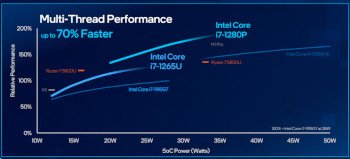
Intel’s comparative benchmark chart for Alder Lake-P
(click image to enlarge)
The only difference we could see in the spec charts is that the P-series chart has changed to show a 28W base TDP. Previously, the P-series was promoted as having a 35W cTDP (for configurable Thermal Design Power) while the SKU chart showed 45W base. The 64W turbo score remains the same.
Intel is now claiming that the highest end Alder Lake-P model, the 14-core, 20-thread Core i7-1270P with 6x Performance/P cores and 8x Efficient/E cores delivers 70 percent faster multi-thread performance compared to a quad-core, 8-thread 11th Gen Tiger Lake-U i7-1195G7, which has a 2.9GHz/5GHz clock and 12-28W cTDP. Intel also claims the same i7-1270P delivers nearly 2x the 3D rendering performance and 30 percent faster photo editing.
According to Engadget, Intel also claimed the P-series i7-1270P offers better multithreaded performance than the more muscular, Tiger Lake-H based Core i9-11980HK while consuming around half as much power. The octa-core, 16-thread i9-11980HK has a 3.3GHz/5GHz clock and 45W to 65W TDP. There were no benchmarks for the U-series models.
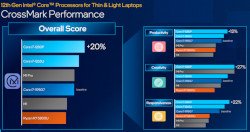

Intel’s CrossMark benchmarks for Alder Lake-P (left) and Avnet’s MSC C6B-ALP
(click images to enlarge)
The P-series rivals the H-series in many aspects. The three P-series SKUs announced by Avnet earlier this month for its Alder Lake-H, -P and U- ready MSC C6B-ALP Basic Type 6 module — the Core i7-1270PE, i5-1250PE, and i3-1220PE — have the same core and thread counts as the three H-series siblings supported by the Avnet module and other Alder Lake-H products announced over the last two months, such as Adlink’s COM-HPC-cADP.
Most of the P-series parts, however, offer fewer of the faster P (Performance) cores vs. E (Efficient) cores compared to similar H-series models. They also have much lower clock rates. In addition, there are several other P-series models that have lower core counts than similar H-series processors, and the P-series lacks the H-series’ high-end i9 models.
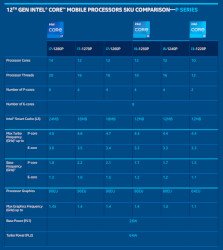
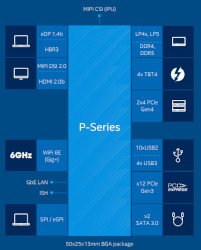
Intel’s pdated Alder Lake-P SKU chart (left) and new block diagram
(click images to enlarge)
Confusingly, the 9W U-series CPUs have the same names as the corresponding 15W models. They have the same core counts and types but with different clock rates.
The U-series parts supported by the Avnet module are among the higher-end 15W TDP U-series models rather than the 9W models. These include the deca-core i7-1265UE and i5-1245UE, the hexa-core i3-1215UE, and 5-core Celeron 7305E. All the U-series 15W models have 1x or 2x P cores and 4x or 8x E cores. The U15 parts have much lower base clock rates than P-series and slightly lower Turbo rates. Like the H- and P-series, the U-series ship with Iris Xe graphics with up to 96EU, depending on the SKU.


Alder Lake U-series split into 15W (left) and 9W categories; the SKUs are the same but clock rates differ
(click images to enlarge)
The 28W P-series lacks the H-series’ PCIe Gen4 x8 PEG interface for graphics, but similarly offers 2x PCIe Gen4 x4 and 12x PCIe Gen3. Additional I/O and support up to DDR5 are identical. The 15W U-series, which has the same 50 x 25 x 13mm footprint as P-series and H-series, has the same I/O and RAM support as the P-series.
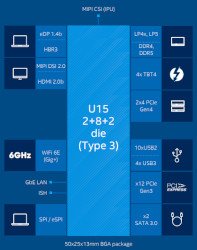
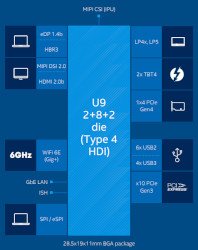
Alder Lake 15W U-series (left) and 9W U-series block diagrams
(click images to enlarge)
Compared to the P-series and 15W U-series, the 28.5 x 19 x 11mm, 9W U-series supports half the Thunderbolt interfaces at 2x and half the PCIe Gen4 x4 at 1x. There are 10x PCIe Gen3 links compared to 12x, 6x USB 2.0 vs. 10x, and no support for SATA. Other I/O specs are the same, including RAM support up to DDR5, WiFi 6E support, 4x USB 3.0, SPI/eSPI, GbE, ISH, eDP 1.4b with HBR3, HDMI 2.0b, MIPI-DSI 2.0, and MIPI-CSI.
Further information
The Alder Lake-P and U-series processors will ship in March on several laptops, with more than 250 coming this year from Acer, Asus, Dell, Fujitsu, HP, Lenovo, LG, MSI, NEC, Samsung and others, says Intel. More information may be found in its announcement and updated 12th Gen product brief, as well as its analyst presentation deck. More on the Xeon and OpenVINO news may be found in Intel’s Xeon announcement, and more on the Intel 12 NUC Extreme may be found here.

Please comment here...